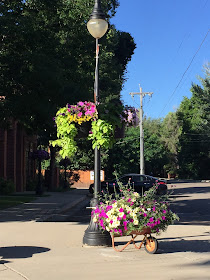 |
| Rudbeckia triloba, Tri River Gardens, Photo by SL Carter |
To some
people, fall might be a four letter but to me it’s one of my favorite times of
the year. Those tomato plants are
finally producing, mornings are cool and crisp, Grand Junction is rarely
hitting 90 degrees and lots of yellow and purple late blooming plants are
blooming. This is also a time when a lot
is going on under the ground. Cool
season turf has perked up, trees are starting to grow more roots and all
perennial plants (trees included) are being like chipmunks and storing up food
to make it through the winter. Here is a
wonderful handout called healthy roots, healthy trees: http://extension.colostate.edu/docs/pubs/garden/02926.pdf
So what can
you do to help your plants make it through winter? Well, for one, since the nights are getting
longer and the days cooler, hopefully you have adjusted how much you are
watering. We need to help slow down plants
so they can harden off for winter. If
you keep giving frequent water, they will continue to grow. So slowly start reducing the times you water
but you may need to increase the length of time you are watering. The best way to check is to use a screwdriver
from the drip edge out on trees to see if it easily slides into the soil to a
depth of 6-8”. If it only gets a couple
of inches down, you definitely need to water deeper. If it comes out all muddy, you have
over-watered. Ideally, you should be
checking your lawn and garden this way thru and season and adjusting the irrigation;
once a month is a good rule to follow.
 |
| Lawn at Mesa County Fairgrounds, Photo by SL Carter |
As the weather cools, cool season
grasses (Kentucky bluegrass, tall fescue and perennial ryegrass) will begin to
grow faster. Mowing will be needed more
often to ensure that the grass is not stressed. No more than one-third of the grass blade
should be removed at each mowing. Continue to maintain the grass at the same
cutting height as during the summer. Even
though lawns grow faster in the fall they will need less water than during the
summer. Adjust your lawn watering accordingly. Here is a handout on watering established
lawns:
This is a good time to install sod. Preparing the soil properly is critical to success. Contact
your local extension office for suggestions.
Do not apply weed killers to newly seeded lawns; wait until the new
grass has been mowed at least twice before spraying for weeds. Sodded lawns can be treated for weeds as soon
as the weeds are noticed. And speaking of herbicides, one of our agents did some
work the last two falls spraying bindweed with glyphosate, and does it work
well. Targeting certain perennial weeds
in fall with the appropriate chemical allows the chemical to be pulled into the
roots as the weed is trying to store energy.
Always read the label and follow the instructions. It is best to make sure what you are using is
appropriate for what you are controlling.
If you only have to do it once, it will save you money too.
At lower/warmer elevations, now is a
good time to plant some cool season greens to get a last batch before winter
gets here. I will say, I hate when
winter gets here and there is no more fresh veggies. So for now I’ll enjoy the cool morning that
still brings abundance. Enjoy!
By Susan L Carter, Horticulture Agent, CSU
Extension, Tri River Area





















